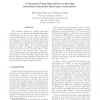Free Online Productivity Tools
i2Speak
i2Symbol
i2OCR
iTex2Img
iWeb2Print
iWeb2Shot
i2Type
iPdf2Split
iPdf2Merge
i2Bopomofo
i2Arabic
i2Style
i2Image
i2PDF
iLatex2Rtf
Sci2ools
IPPS
2006
IEEE
2006
IEEE
A dynamic firing speculation to speedup distributed symbolic state-space generation
The saturation strategy for symbolic state-space generation is very effective for globally-asynchronous locally-synchronous discrete-state systems. Its inherently sequential nature, however, makes it difficult to parallelize on a NOW. An initial attempt that utilizes idle workstations to recognize event firing patterns and then speculatively compute firings conforming to these patterns is at times effective but can introduce large memory overheads. We suggest an implicit method to encode the firing history of decision diagram nodes, where patterns can be shared by nodes. By preserving the actual firing history efficiently and effectively, the speculation is more informed. Experiments show that our implicit encoding method not only reduces the memory requirements but also enables dynamic speculation schemes that further improve runtime.
Decision Diagram Nodes | Distributed And Parallel Computing | Event firing Patterns | Implicit Encoding Method | IPPS 2006 |
| Added | 12 Jun 2010 |
| Updated | 12 Jun 2010 |
| Type | Conference |
| Year | 2006 |
| Where | IPPS |
| Authors | Ming-Ying Chung, Gianfranco Ciardo |
Comments (0)

